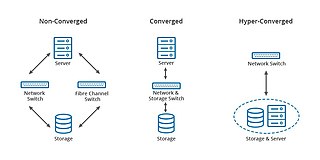In software quality assurance, performance testing is in general a testing practice performed to determine how a system performs in terms of responsiveness and stability under a particular workload. It can also serve to investigate, measure, validate or verify other quality attributes of the system, such as scalability, reliability and resource usage.
Capacity management's goal is to ensure that information technology resources are sufficient to meet upcoming business requirements cost-effectively. One common interpretation of capacity management is described in the ITIL framework. ITIL version 3 views capacity management as comprising three sub-processes: business capacity management, service capacity management, and component capacity management.
In the fields of information technology and systems management, application performance management (APM) is the monitoring and management of the performance and availability of software applications. APM strives to detect and diagnose complex application performance problems to maintain an expected level of service. APM is "the translation of IT metrics into business meaning ."
Performance engineering encompasses the techniques applied during a systems development life cycle to ensure the non-functional requirements for performance will be met. It may be alternatively referred to as systems performance engineering within systems engineering, and software performance engineering or application performance engineering within software engineering.

Splunk Inc. is an American software company based in San Francisco, California, that produces software for searching, monitoring, and analyzing machine-generated data via a web-style interface.
Dynamic Infrastructure is an information technology concept related to the design of data centers, whereby the underlying hardware and software can respond dynamically and more efficiently to changing levels of demand. In other words, data center assets such as storage and processing power can be provisioned to meet surges in user's needs. The concept has also been referred to as Infrastructure 2.0 and Next Generation Data Center.

Parasoft is an independent software vendor specializing in automated software testing and application security with headquarters in Monrovia, California. It was founded in 1987 by four graduates of the California Institute of Technology who planned to commercialize the parallel computing software tools they had been working on for the Caltech Cosmic Cube, which was the first working hypercube computer built.
Business process management (BPM) is the discipline in which people use various methods to discover, model, analyze, measure, improve, optimize, and automate business processes. Any combination of methods used to manage a company's business processes is BPM. Processes can be structured and repeatable or unstructured and variable. Though not required, enabling technologies are often used with BPM.
RTTS is a professional services organization that provides software quality outsourcing, training, and resources for business applications. With offices in New York City, Philadelphia, Atlanta, and Phoenix, RTTS serves mid-sized to large corporations throughout North America. RTTS uses the software quality and test solutions from IBM, Hewlett Packard Enterprise, Microsoft and other vendors and open source tools to perform software performance testing, functional test automation, big data testing, data warehouse/ETL testing, mobile application testing, security testing and service virtualization.
Kaavo is a cloud computing management company. Kaavo was founded in November 2007 in the U.S. Kaavo pioneered top-down application-centric management of cloud infrastructure across public, private, and hybrid clouds.

Converged infrastructure is a way of structuring an information technology (IT) system which groups multiple components into a single optimized computing package. Components of a converged infrastructure may include servers, data storage devices, networking equipment and software for IT infrastructure management, automation and orchestration.
HP Cloud Service Automation is cloud management software from Hewlett Packard Enterprise (HPE) that is used by companies and government agencies to automate the management of cloud-based IT-as-a-service, from order, to provision, and retirement. HP Cloud Service Automation orchestrates the provisioning and deployment of complex IT services such as of databases, middleware, and packaged applications. The software speeds deployment of application-based services across hybrid cloud delivery platforms and traditional IT environments.
In software engineering, service virtualization or service virtualisation is a method to emulate the behavior of specific components in heterogeneous component-based applications such as API-driven applications, cloud-based applications and service-oriented architectures. It is used to provide software development and QA/testing teams access to dependent system components that are needed to exercise an application under test (AUT), but are unavailable or difficult-to-access for development and testing purposes. With the behavior of the dependent components "virtualized", testing and development can proceed without accessing the actual live components. Service virtualization is recognized by vendors, industry analysts, and industry publications as being different than mocking. See here for a Comparison of API simulation tools.
Cloud management is the management of cloud computing products and services.
In the fields of information technology (IT) and systems management, IT operations analytics (ITOA) is an approach or method to retrieve, analyze, and report data for IT operations. ITOA may apply big data analytics to large datasets to produce business insights. In 2014, Gartner predicted its use might increase revenue or reduce costs. By 2017, it predicted that 15% of enterprises will use IT operations analytics technologies.

Data-centric security is an approach to security that emphasizes the dependability of the data itself rather than the security of networks, servers, or applications. Data-centric security is evolving rapidly as enterprises increasingly rely on digital information to run their business and big data projects become mainstream. It involves the separation of data and digital rights management that assign encrypted files to pre-defined access control lists, ensuring access rights to critical and confidential data are aligned with documented business needs and job requirements that are attached to user identities.

Oracle Cloud is a cloud computing service offered by Oracle Corporation providing servers, storage, network, applications and services through a global network of Oracle Corporation managed data centers. The company allows these services to be provisioned on demand over the Internet.
API management is the process of creating and publishing web application programming interfaces (APIs), enforcing their usage policies, controlling access, nurturing the subscriber community, collecting and analyzing usage statistics, and reporting on performance. API Management components provide mechanisms and tools to support developer and subscriber communities.
Data center management is the collection of tasks performed by those responsible for managing ongoing operation of a data center. This includes Business service management and planning for the future.

ModelOps, as defined by Gartner, "is focused primarily on the governance and life cycle management of a wide range of operationalized artificial intelligence (AI) and decision models, including machine learning, knowledge graphs, rules, optimization, linguistic and agent-based models". “ModelOps lies at the heart of any enterprise AI strategy”. It orchestrates the model life cycles of all models in production across the entire enterprise, from putting a model into production, then evaluating and updating the resulting application according to a set of governance rules, including both technical and business KPI's. It grants business domain experts the capability to evaluate AI models in production, independent of data scientists.





